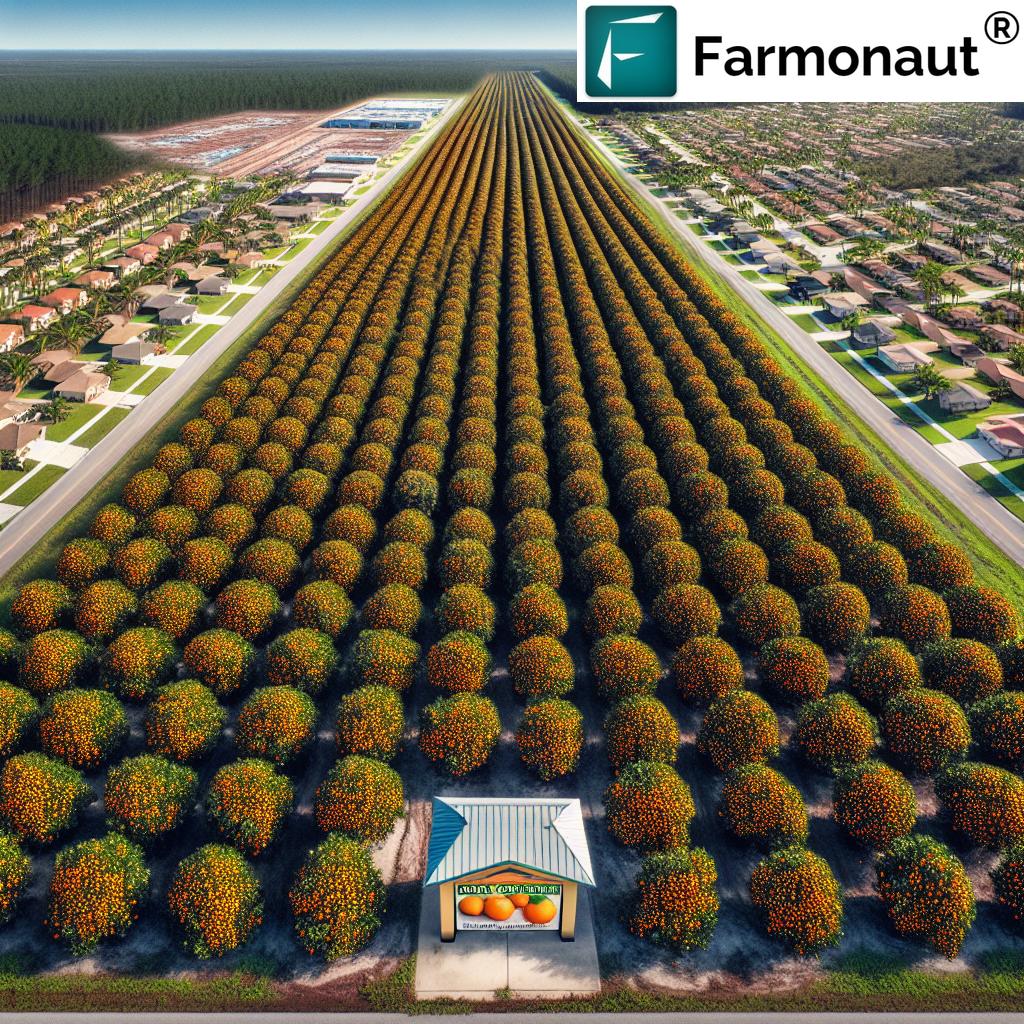Florida’s Citrus Crossroads: Balancing Orange Grove Sustainability Amid Urban Growth and Industry Challenges

“Florida’s citrus industry faces a $6.8 billion economic impact at risk due to declining orange production.”
As we delve into the heart of Florida’s iconic citrus industry, we find ourselves at a critical juncture where tradition meets transformation. The Sunshine State’s orange groves, once a symbol of prosperity and agricultural prowess, now face unprecedented challenges that threaten their very existence. In this comprehensive exploration, we’ll uncover the complex interplay between agriculture, urban growth, and environmental factors that are reshaping Florida’s citrus landscape.
The Citrus Conundrum: A State in Transition
Florida’s citrus industry has long been a cornerstone of the state’s economy and identity. However, recent years have seen a dramatic shift in the fortunes of this once-thriving sector. The convergence of several factors has created a perfect storm that’s testing the resilience of growers and reshaping the future of citrus production in the state.
- Citrus greening disease
- Hurricanes and extreme weather events
- Rapid urban development
- Changing consumer preferences
These challenges have led to a staggering 90% decline in orange production over the past two decades. The impact is felt not just by growers, but across the entire citrus ecosystem, from processors to packing houses, and from nurseries to candy manufacturers.
Polk County: Ground Zero for Growth and Grove Conflict
“Polk County, a major citrus producer, is experiencing rapid urban growth, threatening traditional orange groves.”
Nowhere is the tension between citrus farming and urban development more evident than in Polk County. As the county with the most acres of citrus in Florida, Polk is also experiencing a population boom that’s putting immense pressure on agricultural land.
Trevor Murphy, a third-generation grower in Lake Wales, Florida, paints a vivid picture of this transformation. “At some point, this isn’t going to be an orange grove anymore,” he says, gesturing to the encroaching housing developments surrounding his family’s 20-acre grove.
The statistics are stark:
- In 2023, more people moved to Polk County than any other county in the country
- Citrus groves in Florida have shrunk from over 832,000 acres at the turn of the century to scarcely 275,000 acres last year
- California has now eclipsed Florida as the nation’s leading citrus producer
The Economic Ripple Effect
The decline of Florida’s citrus industry has far-reaching economic implications. With an estimated economic impact of $6.8 billion and 33,000 full-time and part-time jobs at stake, the industry’s struggles are felt across the state.
| Challenge | Impact | Potential Solutions |
|---|---|---|
| Citrus Greening Disease | 90% decline in orange production over 20 years | Research into disease-resistant trees, innovative pest control methods |
| Hurricanes and Extreme Weather | Crop damage, long-term tree health issues | Improved weather forecasting, resilient farming practices |
| Urban Development Pressure | Loss of over 550,000 acres of citrus groves since 2000 | Land conservation initiatives, zoning regulations |
| Declining Orange Juice Consumption | Reduced demand for Florida oranges | Marketing campaigns, product diversification |
| Labor Shortages | Increased production costs, harvest delays | Mechanization, guest worker programs |
The closure of prominent industry groups like the Gulf Citrus Growers Association and the scaling back of operations by major players like Alico Inc. underscore the severity of the situation. Alico’s decision to wind down its citrus operations on more than 53,000 acres is particularly impactful, as it affects processors like Tropicana, which rely on Alico’s fruit to produce orange juice.
The Real Estate Boom: A Double-Edged Sword
As Florida’s population continues to grow, reaching 23 million people last year, the pressure on land use intensifies. The real estate boom presents both a challenge and an opportunity for citrus growers:
- Many growers are selling their land to developers for substantial profits
- Some are using the proceeds to invest in more productive groves or diversify their operations
- The loss of agricultural land raises concerns about food security and environmental sustainability
Trevor Murphy, who also holds a real estate license, exemplifies this duality. While he recently sold acres in Polk County to a home developer, he’s using the money to pay off debt and develop plans to replant thousands of trees in more productive groves.
Technological Solutions and Industry Adaptation
In the face of these challenges, the Florida citrus industry is turning to innovation and technology for solutions. Researchers and agricultural technology companies are at the forefront of this effort.
Farmonaut, a pioneering agricultural technology company, is playing a crucial role in this transformation. By leveraging satellite-based farm management solutions, Farmonaut is helping citrus growers monitor crop health, optimize resource use, and make data-driven decisions. Their platform offers real-time insights that can be particularly valuable in combating citrus greening and adapting to changing environmental conditions.
Other technological advancements in the fight against citrus greening include:
- Genetically modified trees resistant to the Asian citrus psyllid
- Protective screens and white bags to keep insects away from young trees
- Antibiotic injections for infected trees
- Identification and propagation of naturally resistant trees
Dr. Lukasz Stelinski, an entomology professor at the University of Florida, likens the current state of the industry to “being a Lions fan before the Detroit Lions started to win games,” expressing cautious optimism about the turnaround efforts.
Consumer Trends and Market Adaptation
The decline in orange juice consumption in the United States over the past two decades has forced the industry to rethink its approach to marketing and product development. While there was a small uptick during the COVID-19 pandemic, the overall trend remains challenging.
To address this, the industry is exploring:
- New product formulations to appeal to health-conscious consumers
- Marketing campaigns highlighting the nutritional benefits of citrus
- Diversification into other citrus products and value-added goods
Companies like Davidson of Dundee Citrus Candy and Jelly Factory in Lake Wales are adapting by adjusting their product lines and pricing strategies in response to the reduced citrus production.
The Role of Government and Industry Associations
Recognizing the critical importance of the citrus industry to Florida’s economy and identity, government agencies and industry associations are stepping up their efforts to support growers and promote sustainability.
- Increased funding for research into citrus greening disease
- Policy initiatives to protect agricultural land from development
- Support for marketing and promotion of Florida citrus products
Matt Joyner, CEO of trade association Florida Citrus Mutual, emphasized to lawmakers that “Losing the citrus industry is not an option. This industry is … so ingrained in Florida. Citrus is synonymous with Florida.”
Environmental Considerations and Sustainable Practices
As the industry grapples with its challenges, there’s a growing focus on environmental sustainability and responsible land management. This includes:
- Water conservation techniques
- Integrated pest management to reduce chemical use
- Soil health improvement strategies
Farmonaut’s satellite-based monitoring systems can play a crucial role in these efforts by providing precise data on soil moisture, crop health, and resource utilization. This technology enables growers to make informed decisions that balance productivity with environmental stewardship.
Explore Farmonaut’s API for advanced agricultural data integration
The Future of Florida’s Citrus Industry
As we look to the future, the Florida citrus industry stands at a crossroads. The path forward will require a delicate balance of tradition and innovation, of preserving agricultural heritage while embracing new technologies and practices.
Key factors that will shape the industry’s future include:
- Success of ongoing research into disease-resistant trees
- Adoption of precision agriculture technologies
- Consumer trends and market demand for citrus products
- Land use policies and urban development patterns
- Climate change adaptation strategies

Conclusion: A Call for Collaborative Action
The challenges facing Florida’s citrus industry are complex and multifaceted, requiring a collaborative approach from growers, researchers, policymakers, and technology providers. While the road ahead is uncertain, the resilience and innovation demonstrated by the industry offer hope for a sustainable future.
As we navigate this critical period, technologies like those offered by Farmonaut will play an increasingly important role in helping growers adapt and thrive. By leveraging data-driven insights and precision agriculture techniques, the Florida citrus industry can work towards a future that balances productivity, sustainability, and economic viability.
Access Farmonaut’s API Developer Docs for integration guidance
The story of Florida’s citrus industry is far from over. With continued innovation, supportive policies, and a commitment to sustainability, there’s hope that the iconic orange groves will remain a vital part of Florida’s landscape and economy for generations to come.
FAQ Section
- What is citrus greening disease?
Citrus greening disease, also known as Huanglongbing (HLB), is a bacterial infection spread by the Asian citrus psyllid. It causes trees to produce bitter, misshapen fruit and eventually leads to tree death. - How has urban development affected Florida’s citrus industry?
Urban development has led to the conversion of many citrus groves into housing developments, particularly in fast-growing counties like Polk. This has resulted in a significant reduction in citrus acreage across the state. - What role does technology play in addressing citrus industry challenges?
Technology, such as Farmonaut’s satellite-based monitoring systems, plays a crucial role in helping growers optimize resource use, monitor crop health, and make data-driven decisions to improve productivity and sustainability. - How are researchers working to combat citrus greening disease?
Researchers are developing genetically modified trees resistant to the disease, exploring antibiotic treatments, and identifying naturally resistant trees for propagation. - What is the economic impact of Florida’s citrus industry?
The Florida citrus industry has an estimated economic impact of $6.8 billion and supports approximately 33,000 full-time and part-time jobs.
Farmonaut Subscription Options
Earn With Farmonaut: Affiliate Program
Earn 20% recurring commission with Farmonaut’s affiliate program by sharing your promo code and helping farmers save 10%. Onboard 10 Elite farmers monthly to earn a minimum of $148,000 annually—start now and grow your income!






